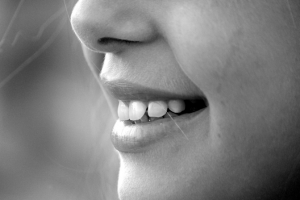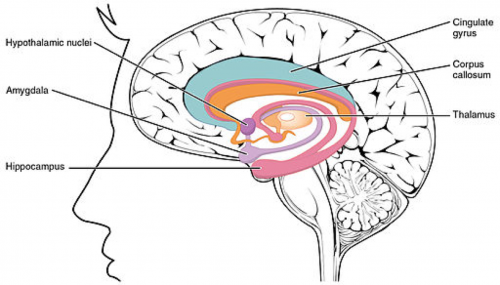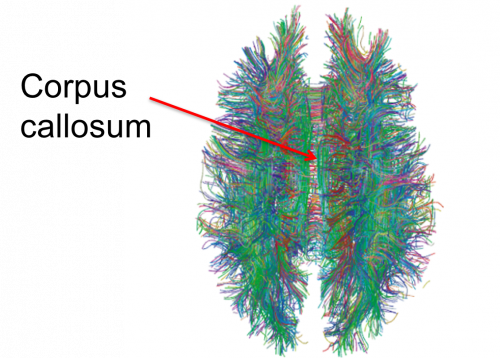2-1 What is the Brain?
A – How the Brain Works
Role of the Brain
We start off this topic with a discussion about what the brain is. We don’t just use our brains for thinking and learning. The main role of the brain and nervous system is to create and direct behaviors. And it does this based on a perception of the world that it also creates.
Our brains and nervous systems create the world that we live in and experience everyday. Our brains are integral to who we are, and, as will become evident a bit later, each brain is unique to that person.
Our nervous systems perceive physical changes in the world, such as patterns of light and dark, sound waves, changes in pressure or temperature, and the presence of different types of molecules in food or air. Brains take in all of these many inputs and create a perception of the world based on those inputs.
Video: Whodunnit? (1:54)
This video is about a murder mystery. As you watch the video consider who you think committed the crime?
Watch Whodunnit from VoicesOnCall on YouTube.

Video Debrief
During the video, a detective asks suspects some questions and names the murderer at the end. However, the true point of the video is as a demonstration of selective attention.
What is selective attention? (click to toggle expand/collapse)
At 55 seconds, the screen narrative asks the viewer: “Did you notice the 21 changes?”
The clip then plays again, but this time from behind the camera. This angle reveals the 21 scene changes that happened during the video, with changes that affect the victim, room decorations, and a large item in the back of the room.
You may want to watch the initial video again so that you can see that some of the changes are quite noticeable when you are looking for them.
You can thank your nervous system for the experiences you had or did not have as you were watching this video.
What we see, hear, feel, taste, or smell are all renderings of physical stimuli from the world created by our brains.
Two Noses, Two Perceptions


The way the human nervous system perceives the world may be very different than say, the way a dog perceives the world. Human brains and bodies are specialized for different tasks.
For example, have you ever noticed a dog tracking a scent through the grass? Even if you tried very hard, do you think you would be able to trace, let alone detect that smell?
For you, that smell doesn’t exist as part of your experience of the world. But for the dog, that smell is an integral part of its experience. And the dog will choose to take different actions based on the fact that the smell is part of its reality.
What we perceive, act on, and remember is a result both of what our nervous system is physically capable of responding to, as well as what we are paying attention to at the time.
As we talk about brain development, think about how people’s brains shape the way that they perceive every moment of their lives and link to every facet of children’s development.
B – Regions of the Brain
Multiple Zones
Let’s take some time to review information about the regions of the brain.
The brain has different functional and structural regions. These regions are called lobes. Each lobe is specialized for a particular set of tasks.
We use all of our brains constantly. Your brain works continuously, rapidly sending information between these different regions, determining what you should say, do, and feel at any given moment.
 Interactive: Regions of the Brain
Interactive: Regions of the Brain
This is an interactive element! Click on the plus signs to reveal more about the regions of the brain.
Image credit: EarlyEdU
The Limbic System

So far, we’ve highlighted regions in the cerebral cortex and the cerebellum. But those aren’t the only regions in the brain.
The limbic system is a network of structures located below the cerebral cortex and above the brain stem. These closely connected structures help regulate day-to-day behaviors and emotions. We will briefly discuss two limbic system structures that you have likely heard of—the hippocampus and the amygdala.
We briefly talked about the hippocampus when we discussed the temporal lobes. The hippocampus plays an important role in the formation of new memories. To do this, the hippocampus takes information from different regions of the brain and consolidates them into memory.
Think of a day that you remember vividly. Can you remember sounds, smells, and colors?
Your hippocampus helped to make sure that all this information, collected from different regions of the brain, is stored together in one memory.
You may have heard of the amygdala before. Often the amygdala’s role in the brain is overly simplified and linked only with fear.
But the role of the amygdala is more complex than that. The amygdala helps us feel certain emotions and recognize them in others. The amygdala is particularly active during events in our lives that are important to our survival. This brain region helps us regulate our reactions to the presence of danger, rivals, food, or a particularly attractive mate.
Connecting Brain Regions

The last lesson pointed out bundles of axons called fiber tracts that connect the many regions of the brain. These information superhighways allow neural messages to travel quickly from region to region.
We use all of our brain constantly, not just a certain part, or a certain percentage. In any task that we do, we are using many regions of our brains, which are working and coordinating together.
This image shows a three-dimensional model of many of the white matter fiber tracts in the brain. Last lesson, we learned that white matter is bundles of myelinated axons. This image is a view looking straight down at the top of the head.
A band of fibers connect the two sides or hemispheres of the brain. This area of fiber tracts is called the corpus callosum, and it allows the two sides of the brain to constantly interact.
 References
References
Do the Test. (2008, November 3). Test your awareness: Whodunnit [Video File].
Gigandet, X. (2008, December 23). White matter connections obtained with MRI tractography [Online image]. In Estimating the Confidence Level of White Matter Connections Obtained with MRI Tractography, PLoS ONE, 3(12), 1-9. [Journal article]
OpenStax College. (2013). 15-3 Central control. Textbooks by OpenStax. [Image].
EarlyEdU Alliance (Publisher). (2018). 2-1 What is the brain? In Child Development: Brain Building Course Book. University of Washington. [UW Pressbooks]

